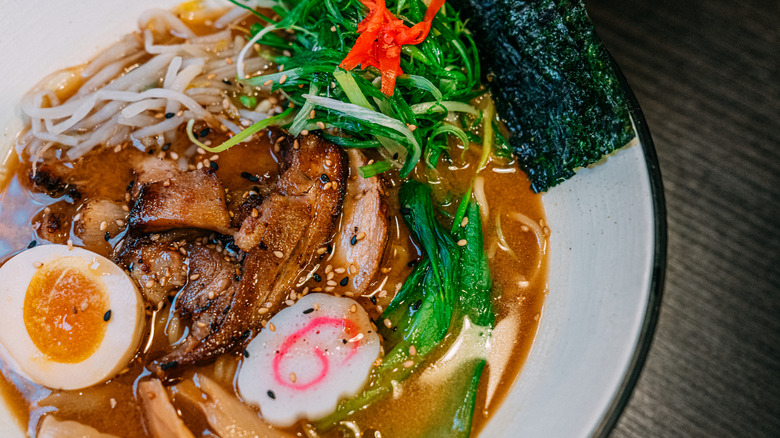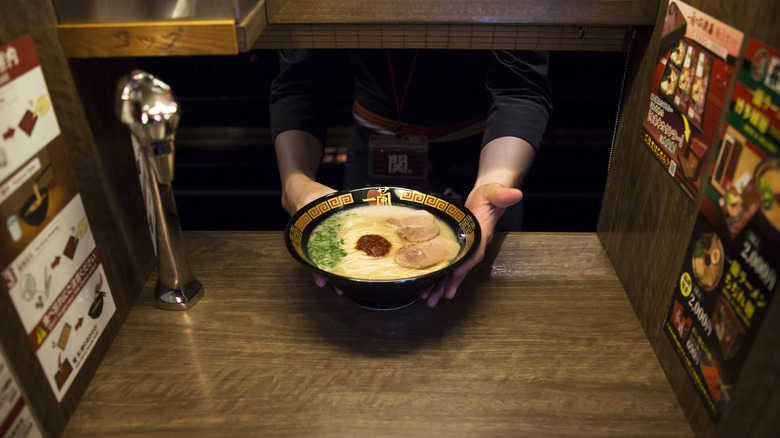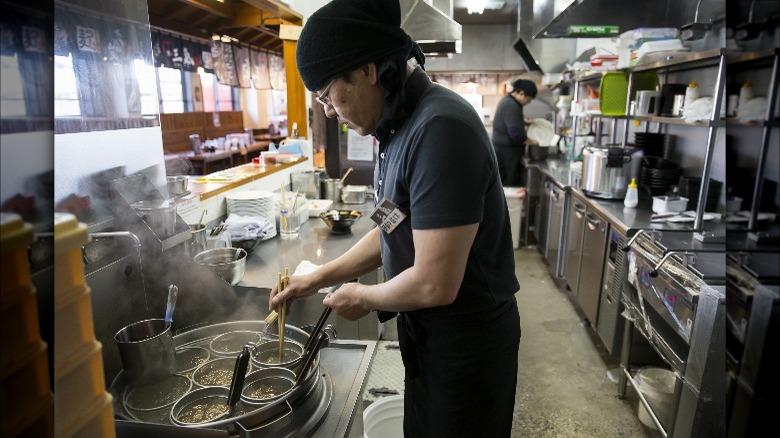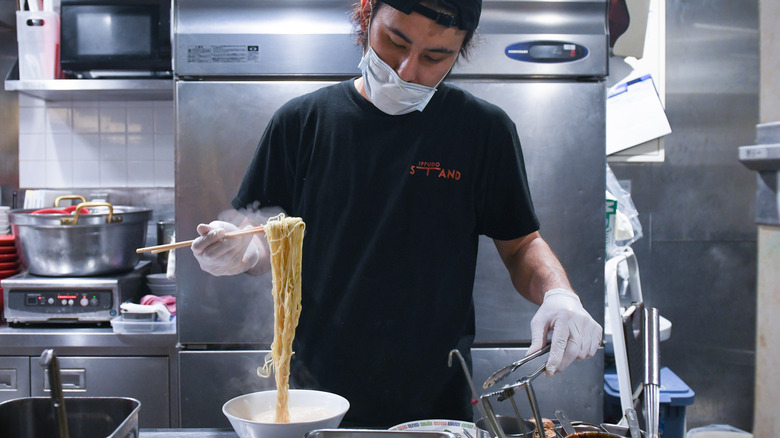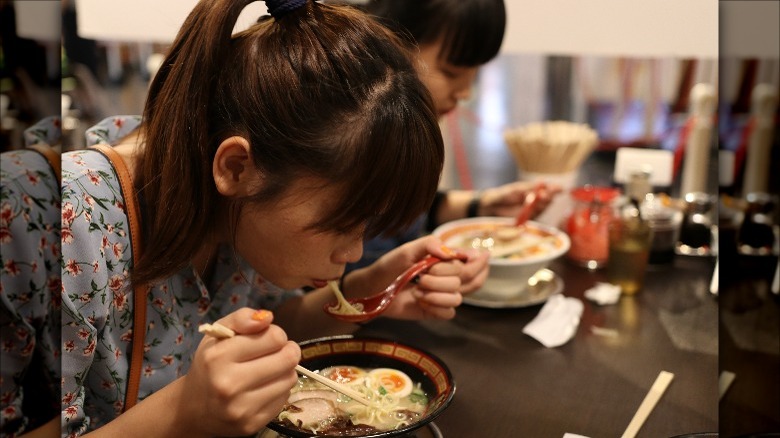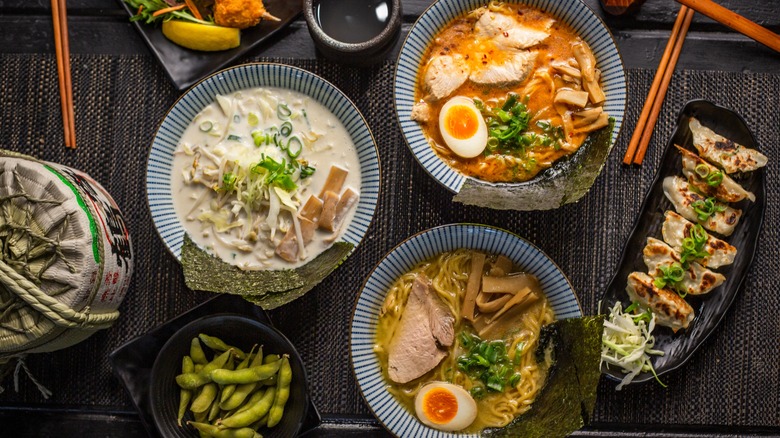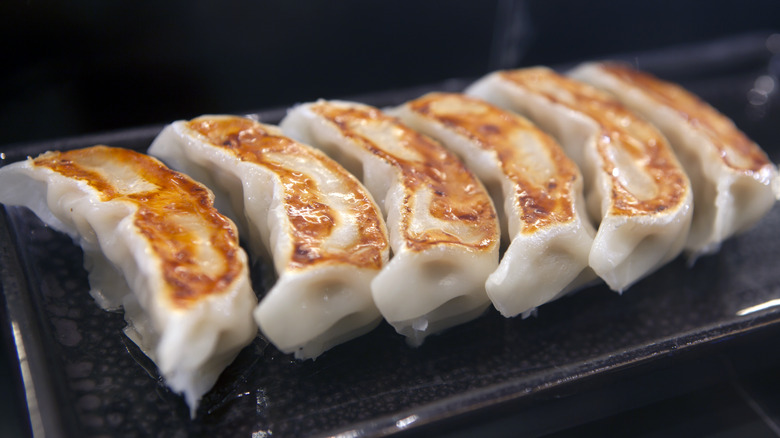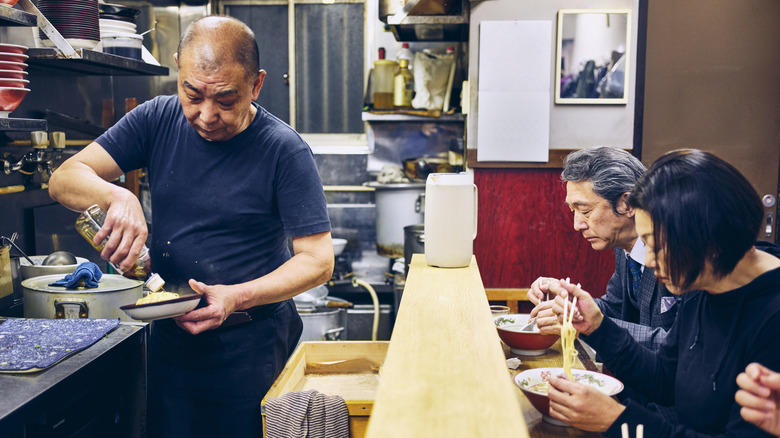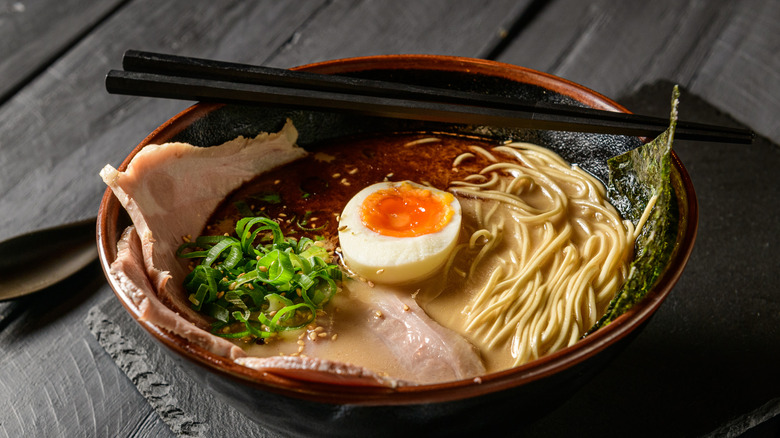What Is Tonkotsu And What Does It Taste Like?
Few dishes are as heartwarming and comforting as a hot bowl of ramen on a chilly day. Although the Japanese noodle soup has been around for centuries, it has taken the world by storm — and no, we're not talking about the instant noodle cups you survived on during college. Since its inception in the 1800s, ramen has taken several forms, with dozens of regional varieties around Japan, all featuring various toppings, broths, condiments, and seasonings.
Digging into the varieties of ramen can take a lifetime of study, but general broth styles include shio, shoyu, and miso — with each of those broken down into further categories depending on the region and style. But today, we're going to focus on one type of ramen — tonkotsu. Tonkotsu ramen has become one of the most popular types of Japanese noodles in the world, but what exactly is it? And how does it differ from other types of ramen? Keep reading to learn more about this deep, flavorful noodle soup.
What is tonkotsu ramen?
In Japanese, the term "tonkotsu" essentially means pork bones, which is the defining ingredient in this type of ramen. The term refers to the broth that is slow-cooked using pork bones for a long time — even up to several days. A combination of collagen-rich parts of the pig is added to the water, including neck bones and pork trotters, which eventually lends gelatin to the broth, giving it that incomparable, mouth-coating texture. It usually results in an opaque, cloudy-white broth.
After the broth is made, it is often combined with a "tare," the seasoning that flavors the soup base, which includes shoyu (soy sauce), shio (salt), or miso (fermented bean paste). Next, the famous, springy, ramen noodles are added. Although there are several signature styles of the dish, some classic toppings include chashu (braised pork belly), soft-boiled eggs, bean sprouts, sesame seeds, green onions, shiitake mushrooms, bok choy, and nori (thin sheets of dried seaweed). Together, the ingredients create a deep, umami-packed combination of flavors that stick in the mouth for hours after eating.
What is the history of tonkotsu ramen?
Although the roots of ramen can be traced back to Chinese wheat noodles called keitai-men in the 1800s, tonkotsu is a relatively newer category of ramen that was created in Kurume City, Fukuoka around 1937. According to legend, the original recipe was created at a ramen shop called Nankin Senryo. It was a kind of hybrid between shoyu-based ramen and pork-based soup. However, it didn't get its signature cloudiness until a nearby ramen shop called Sankyu came along. The discovery of this popular dish was a total accident by a man named Katsumi Sugino-san who served ramen from his outdoor food stall.
One day, he went out shopping and left his mother in charge of the food stall while he was out. When he got back, he found the soup had completely overboiled, turning it into a unique white color in the process. At first, he thought he wouldn't be able to sell the product, but he made one last-ditch effort to save the ramen and seasoned it with what he could. In the end, he created a dish that was incredibly umami-packed — and even better than his original recipe. As a result, his ramen shop became incredibly popular. His tonkotsu style became a thing of legend, and other ramen chefs learned his technique while spreading the gospel of the pork broth across the country, and then the world.
How is tonkotsu ramen made?
Tonkotsu ramen isn't something you can just throw together in an hour. It's a long labor of love that can take more than a day to perfect. The heart of tonkotsu ramen is right there in the name — it starts with pork bones to create that deep, rich broth. The bones are boiled for hours, sometimes up to 60 hours, in order to break down all of the fat and marrow and to create that gelatin-like consistency. Other vegetables can be added to the broth, like onions, scallions, and mushrooms. The best ramen shops might even add extra pork fat into the boiling pot to get an incomparable richness to the broth.
After a tare of some sort is added to the broth, some type of fat or oil is added, such as vegetable oil, seasoning oil, or animal fat that forms a sort of "skin" on top of the noodle soup. Ramen noodles are then added, followed by a wide variety of toppings, including chashu, soft-boiled eggs, pickled bamboo shoots, spinach, mushrooms, and more. The result is an addicting, flavor-packed bowl of noodles.
What does tonkotsu taste like?
The first words that come to mind when eating a bowl of tonkotsu ramen are creamy, heartwarming, and umami. Combined with bouncy, chewy noodles and other savory toppings like chashu pork and soft-boiled eggs, it creates a deep, hearty flavor that leaves your taste buds craving more and more.
The painstaking process that breaks down the pork bones results in an incredibly velvety texture that leaves an intensely satisfying creamy flavor with every slurp. Tonkotsu ramen could be the poster child for the term umami, which is often referred to as the "fifth taste" — a combination of saltiness, richness, and sweetness. The broth is often described as coating the mouth and tongue, giving the eater a specific type of mouthfeel that feels almost indulgent. This is created by the breakdown of collagen and marrow from the bones. The fat gets emulsified with the broth, giving it a thicker-than-normal-liquid kind of feeling.
From there, the combinations of tonkotsu ramen "tastes" are endless. Besides the different toppings that can be added to the soup, the tare and condiments can be tinkered with to create a completely customized bowl of tonkotsu. This is why you find such specific differences in regional bowls of ramen in Japan — even though they may be classified as the same "type."
How does tonkotsu compare to other types of ramen?
Tonkotsu isn't the only ramen out there. Depending on who you ask, there are four "main" types of ramen, with countless variations of each type. Not only are there tons of regional varieties in Japan, but because of the popularity of the noodle dish in the world, innovative chefs in the U.S. and other countries have also begun creating their own versions of the dish. With that said, how does tonkotsu compare to other types of ramen? Let's break them down.
The first type of ramen is shoyu, which is based on soy sauce. This type originates from central Japan in the Yokohama region. Shoyu ramen usually has a salty and tangy flavor and is often paired with chicken and seafood broths, but sometimes pork and beef as well. Next up is shio ramen, which is based on sea salt. This is a much milder and lighter soup, especially when compared to the deep flavor of tonkotsu broth. Finally, miso ramen originates from the Sapporo region of Hokkaido and is based on its main ingredient and namesake: miso. The broth is stronger and more savory.
Each type of ramen has its own specific characteristics and ingredients that make them special, and are often further customized depending on who's making it. Compared to these types of ramen, tonkotsu is probably the deepest and creamiest of the bunch.
What sides do you eat with tonkotsu ramen?
If you've had a hearty bowl of tonkotsu ramen before, you probably know that a bowl is often more than enough to satisfy your cravings without any sides to go along with it. The toppings of a bowl of ramen can often be described as the "sides" — which often include chashu pork belly, marinated "ramen eggs," bean sprouts, shiitake mushrooms, fish cake, and more. In fact, many ramen shops have limited menus and may not even serve sides at all.
But of course, several places offer delicious sides that can complement the dish as well. One side that is served in some ramen shops is umeboshi, the Japanese pickled plum. These plums offer an incredibly sour, salty flavor that complements the depth of a bowl of ramen. Other common side dishes with ramen are gyoza (dumplings) or fried rice.
As ramen continues to take off all around the world, several other sides have been paired with the delicious noodle dish, such as edamame beans, refreshing salads, yakitori skewers, or even kimchi, a popular Korean fermented cabbage.
Where to buy tonkotsu ramen
Nowadays, ramen has become incredibly popular around the world. Finding a ramen shop is becoming easier and easier for those living outside of the noodle dish's home country. When it comes to getting the ingredients to make tonkotsu, your best bet is to head down to your local Asian supermarket. Although it would be better to find a local Japanese grocery store, most Asian markets (like the Korean H Mart) tend to diversify their products to carry other popular Asian products, like the kinds you need to make tonkotsu for yourself.
Nowadays, you can also head online to order the products you need to make ramen at home without stepping out of your house, which can be especially useful for those that don't live near any Asian supermarkets. You can order from places like Umami Mart, The Japanese Pantry, Just Asian Food, or even Amazon for most of the products you need. You'll even find instant varieties of tonkotsu there as well.
With that said, even if you don't have access to all the Japanese ingredients, the beauty of ramen is it's quite customizable. Tonkotsu broth is based on pork bones, which are accessible in most places. From there, you can tinker with recipes to suit what ingredients you have to make a delicious version of tonkotsu ramen for yourself.
Nutritional information about tonkotsu
Although tonkotsu ramen is delicious, no one ever said it was the best diet food. The dish is relatively high in calories. A typical bowl of tonkotsu has around 1,000 calories in a single bowl. Ramen is also a carb-heavy dish due to the noodles, and typically has around 91 grams of carbohydrates. As mentioned earlier, tonkotsu ramen relies on a thick, creamy broth, which has around 44 grams of fat. Among the four types of ramen, tonkotsu has the most calories. Shoyu and shio ramen typically have the least amounts, coming in at around 700 calories, followed by miso ramen at 800 calories.
Why is tonkotsu ramen so much heavier than the other types? Well, the broth, to start. A typical recipe for tonkotsu broth has 357 calories in a serving — and that's just the broth. The boiled pork bones release fat, gelatin, and other things that make the broth so delicious, but unfortunately, it comes with a higher calorie and fat count as well. The famous Momofuku's pork ramen has over 1,200 calories.
Although tonkotsu ramen probably shouldn't be on your go-to diet food, it's definitely a flavor bomb that's worth treating yourself to once in a while.
